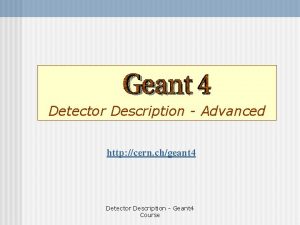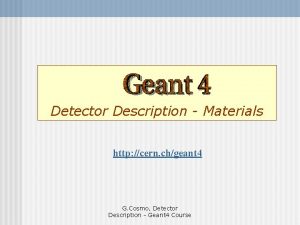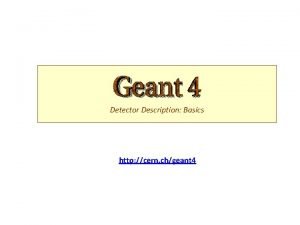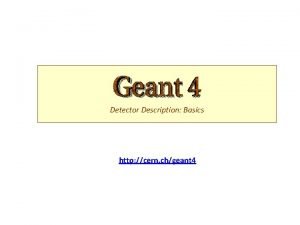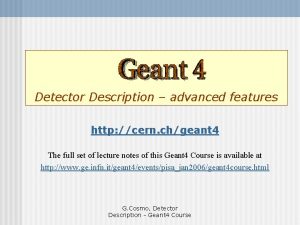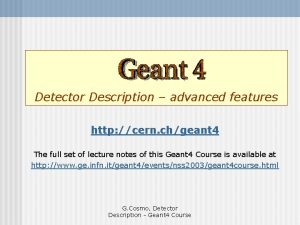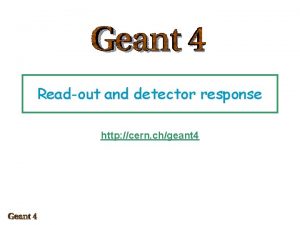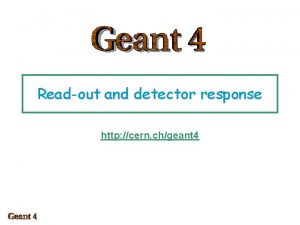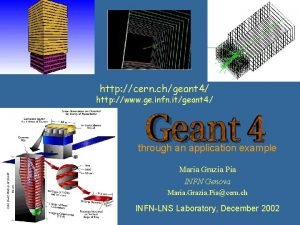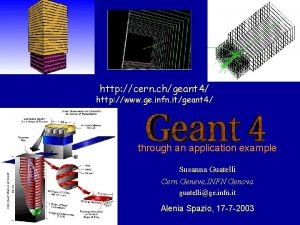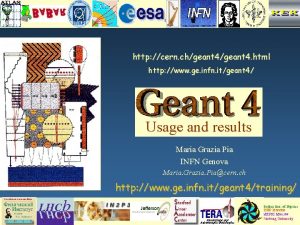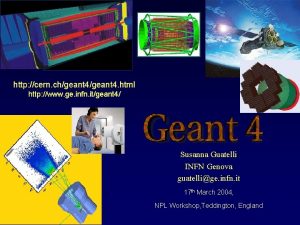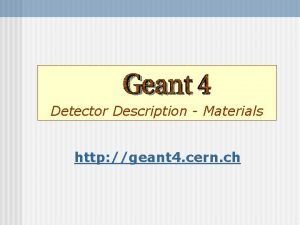Detector Description Materials http cern chgeant 4 PART






















- Slides: 22

Detector Description: Materials http: //cern. ch/geant 4

PART I Materials - The System of units & constants - Definition of elements - Materials and mixtures - Some examples … - The NIST Data Base

Units • Geant 4 has no default unit. To give a number, unit must be “multiplied” to the number. – for example : G 4 double width = 12. 5*m; G 4 double density = 2. 7*g/cm 3; – If no unit is specified, the internal G 4 unit will be used, but this is discouraged ! – Almost all commonly used units are available. – The user can define new units. – Refer to CLHEP: System. Of. Units. h • Divide a variable by a unit you want to get. G 4 cout << d. E / Me. V << “ (Me. V)” << G 4 endl; Detector Description: Materials - Geant 4 Course 3

System of Units • System of units are defined in CLHEP, based on: – millimetre (mm), nanosecond (ns), Mega e. V (Me. V), positron charge (eplus) degree Kelvin (kelvin), the amount of substance (mole), luminous intensity (candela), radian (radian), steradian (steradian) • All other units are computed from the basic ones • In output, Geant 4 can choose the most appropriate unit to use. Just specify the category for the data (Length, Time, Energy, etc…): G 4 cout << G 4 Best. Unit(Step. Size, “Length”); will be printed in km, m, mm or … fermi, depending on its value Step. Size Detector Description: Materials - Geant 4 Course 4

Defining new units • New units can be defined directly as constants, or (suggested way) via G 4 Unit. Definition – G 4 Unit. Definition ( name, symbol, category, value ) • Example (mass thickness): – G 4 Unit. Definition (“grammpercm 2”, “g/cm 2”, “Mass. Thickness”, g/cm 2); – The new category “Mass. Thickness” will be registered in the kernel in G 4 Units. Table • To print the list of units: – From the code G 4 Unit. Definition: : Print. Units. Table(); – At run-time, as UI command: Idle> /units/list Detector Description: Materials - Geant 4 Course 5

Definition of Materials • Different kinds of materials can be defined: – – isotopes <> G 4 Isotope elements <> G 4 Element molecules <> G 4 Material compounds and mixtures <> G 4 Material • Attributes associated: – temperature, pressure, state, density Detector Description: Materials - Geant 4 Course 6

Isotopes, Elements and Materials • G 4 Isotope and G 4 Element describe the properties of the atoms: – Atomic number, number of nucleons, mass of a mole, shell energies – Cross-sections per atoms, etc… • G 4 Material describes the macroscopic properties of the matter: – temperature, pressure, state, density – Radiation length, absorption length, etc… • G 4 Material is the class used for geometry definition Detector Description: Materials - Geant 4 Course 7

Elements & Isotopes • Isotopes can be assembled into elements G 4 Isotope (const G 4 String& G 4 int G 4 double name, z, // atomic number n, // number of nucleons a ); // mass of mole • … building elements as follows: G 4 Element (const G 4 String& name, const G 4 String& symbol, // element symbol G 4 int n. Iso ); // # of isotopes G 4 Element: : Add. Isotope(G 4 Isotope* iso, // isotope G 4 double rel. Abund); // fraction of atoms // per volume Detector Description: Materials - Geant 4 Course 8

Material of one element • Single element material G 4 double density = 1. 390*g/cm 3; G 4 double a = 39. 95*g/mole; G 4 Material* l. Ar = new G 4 Material("liquid. Argon", z=18. , a, density); • Prefer low-density material to vacuum Detector Description: Materials - Geant 4 Course 9

Material: molecule • A Molecule is made of several elements (composition by number of atoms): a = 1. 01*g/mole; G 4 Element* el. H = new G 4 Element("Hydrogen", symbol="H", z=1. , a); a = 16. 00*g/mole; G 4 Element* el. O = new G 4 Element("Oxygen", symbol="O", z=8. , a); density = 1. 000*g/cm 3; G 4 Material* H 2 O = new G 4 Material("Water", density, ncomp=2); H 2 O->Add. Element(el. H, natoms=2); H 2 O->Add. Element(el. O, natoms=1); Detector Description: Materials - Geant 4 Course 10

Material: compound • Compound: composition by fraction of mass a = 14. 01*g/mole; G 4 Element* el. N = new G 4 Element(name="Nitrogen", symbol="N", z= 7. , a); a = 16. 00*g/mole; G 4 Element* el. O = new G 4 Element(name="Oxygen", symbol="O", z= 8. , a); density = 1. 290*mg/cm 3; G 4 Material* Air = new G 4 Material(name="Air", density, ncomponents=2); Air->Add. Element(el. N, 70. 0*per. Cent); Air->Add. Element(el. O, 30. 0*per. Cent); Detector Description: Materials - Geant 4 Course 11

Material: mixture • Composition of compound materials G 4 Element* el. C = …; G 4 Material* Si. O 2 = …; G 4 Material* H 2 O = …; // define “carbon” element // define “quartz” material // define “water” material density = 0. 200*g/cm 3; G 4 Material* Aerog = new G 4 Material("Aerogel", density, ncomponents=3); Aerog->Add. Material(Si. O 2, fractionmass=62. 5*per. Cent); Aerog->Add. Material(H 2 O , fractionmass=37. 4*per. Cent); Aerog->Add. Element (el. C , fractionmass= 0. 1*per. Cent); Detector Description: Materials - Geant 4 Course 12

Example: gas • It may be necessary to specify temperature and pressure – (d. E/dx computation affected) G 4 double density = 27. *mg/cm 3; G 4 double temperature = 325. *kelvin; G 4 double pressure = 50. *atmosphere; G 4 Material* CO 2 = new G 4 Material(“Carbonic. Gas", density, ncomponents=2 k. State. Gas, temperature, pressure); CO 2 ->Add. Element(C, natoms = 1); CO 2 ->Add. Element(O, natoms = 2); Detector Description: Materials - Geant 4 Course 13

Example: vacuum • Absolute vacuum does not exist. It is a gas at very low density ! – Cannot define materials composed of multiple elements through Z or A, or with r=0 G 4 double atomic. Number = 1. ; G 4 double mass. Of. Mole = 1. 008*g/mole; G 4 double density = 1. e-25*g/cm 3; G 4 double temperature = 2. 73*kelvin; G 4 double pressure = 3. e-18*pascal; G 4 Material* Vacuum = new G 4 Material(“inter. Galactic", atomic. Number, mass. Of. Mole, density, k. State. Gas, temperature, pressure); Detector Description: Materials - Geant 4 Course 14

Gas mixture by volume ? • Example: Ar (80%) CO 2 (20%) – In 10 moles of mixture : 8 moles of Ar, 2 moles of CO 2 à The mixture is equivalent (for mass fraction) to the molecule Ar 8 C 2 O 4 Detector Description: Materials - Geant 4 Course 15

PART II NIST Material Data-Base in Geant 4 - Class structure - NIST Isotopes, Elements and Materials - How to use it …

NIST Manager & Messenger • NIST database for materials is imported inside Geant 4 http: //physics. nist. gov/Phys. Ref. Data • Additional interfaces defined • UI commands specific for handling materials • The best accuracy for the most relevant parameters guaranteed: • • • Density Mean excitation potential Chemical bounds Element composition Isotope composition Various corrections Detector Description: Materials - Geant 4 Course 17

NIST Elements & Isotopes Z A m error (%) Aeff ============= 14 Si 22 23 24 25 26 27 28 29 30 31 32 33 34 35 36 37 38 39 40 41 42 22. 03453 (22) 23. 02552 (21) 24. 011546 (21) 25. 004107 (11) 25. 992330 (3) 26. 98670476 (17) 27. 9769265327 (20) 28. 97649472 (3) 29. 97377022 (5) 30. 97536327 (7) 31. 9741481 (23) 32. 978001 (17) 33. 978576 (15) 34. 984580 (40) 35. 98669 (11) 36. 99300 (13) 37. 99598 (29) 39. 00230 (43) 40. 00580 (54) 41. 01270 (64) 42. 01610 (75) 28. 0855(3) 92. 2297 (7) 4. 6832 (5) 3. 0872 (5) • Natural isotope compositions • More than 3000 isotope masses • Used for elements definition Detector Description: Materials - Geant 4 Course 18

================== ### Elementary Materials from the NIST Data Base ================= Z Name Ch. Formula density(g/cm^3) I(e. V) ================== 1 G 4_H H_2 8. 3748 e-05 19. 2 2 G 4_He 0. 000166322 41. 8 3 G 4_Li 0. 534 40 4 G 4_Be 1. 848 63. 7 5 G 4_B 2. 37 76 6 G 4_C 2 81 7 G 4_N N_2 0. 0011652 82 8 G 4_O O_2 0. 00133151 95 9 G 4_F 0. 00158029 115 10 G 4_Ne 0. 000838505 137 11 G 4_Na 0. 971 149 12 G 4_Mg 1. 74 156 13 G 4_Al 2. 6989 166 14 G 4_Si 2. 33 173 NIST Materials • NIST Elementary materials: • H -> Cf ( Z = 1 -> 98 ) • NIST compounds: • e. g. “G 4_ADIPOSE_TISSUE_IRCP” • HEP and Nuclear materials: • e. g. Liquid Ar, Pb. WO • It is possible to build mixtures of NIST and user-defined materials ================== ### Compound Materials from the NIST Data Base ================== N Name Ch. Formula density(g/cm^3) I(e. V) ================== 13 G 4_Adipose_Tissue 0. 92 63. 2 1 0. 119477 6 0. 63724 7 0. 00797 8 0. 232333 11 0. 0005 12 2 e-05 15 0. 00016 16 0. 00073 17 0. 00119 19 0. 00032 20 2 e-05 26 2 e-05 30 2 e-05 4 G 4_Air 0. 00120479 85. 7 6 0. 000124 7 0. 755268 8 0. 231781 18 0. 012827 2 G 4_Cs. I 4. 51 553. 1 53 0. 47692 55 0. 52308 Detector Description: Materials - Geant 4 Course 19

How to use the NIST DB • No need to predefine elements and materials • Retrieve materials from NIST manager: G 4 Nist. Manager* manager = G 4 Nist. Manager: : Instance(); G 4 Material* H 2 O = manager->Find. Or. Build. Material(“G 4_WATER”); G 4 Material* mat = manager->Construct. New. Material(“name”, const std: : vector<G 4 String>& elements, const std: : vector<G 4 double>& weights, G 4 double density, G 4 bool isotopes); G 4 double isotope. Mass = manager->Get. Mass(G 4 int Z, G 4 int N); • Some UI commands … /material/nist/print. Element print defined elements /material/nist/list. Materials print defined materials Detector Description: Materials - Geant 4 Course 20

Material Scanner • Tool to measure material thickness in units of geometrical length, radiation length and interaction length – Region sensitive: you can measure thickness of one particular region • /control/mat. Scan – scan - Start material scanning – theta - Define theta range – phi - Define phi range – single. Measure - Measure thickness for one particular direction – eye. Position - Define the eye position – region. Sensitive - Set region sensitivity – region - Define region name to be scanned Detector Description: Materials - Geant 4 Course 21

Exercise 1 a • Materials
 Technical description examples
Technical description examples Favourite cars
Favourite cars Science useful and harmful materials
Science useful and harmful materials Man made map
Man made map Adopting materials
Adopting materials Direct materials budget with multiple materials
Direct materials budget with multiple materials Licenseid=string&content=string&/paramsxml=string
Licenseid=string&content=string&/paramsxml=string Http //mbs.meb.gov.tr/ http //www.alantercihleri.com
Http //mbs.meb.gov.tr/ http //www.alantercihleri.com Http //siat.ung.ac.id atau http //pmb.ung.ac.id
Http //siat.ung.ac.id atau http //pmb.ung.ac.id Peas for automated taxi driver
Peas for automated taxi driver Medical diagnosis system peas
Medical diagnosis system peas Peas for part picking robot
Peas for part picking robot Peas description for interactive english tutor
Peas description for interactive english tutor Part picking robot peas
Part picking robot peas Peas description in ai
Peas description in ai Part part whole addition
Part part whole addition Unit ratio definition
Unit ratio definition Part part whole
Part part whole Describe the parts of a front bar?
Describe the parts of a front bar? The part of a shadow surrounding the darkest part
The part of a shadow surrounding the darkest part Two way anova minitab 17
Two way anova minitab 17 Detector building science olympiad cheat sheet
Detector building science olympiad cheat sheet Junction semiconductor detector
Junction semiconductor detector























